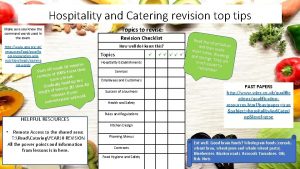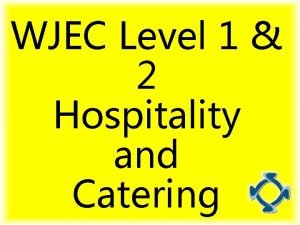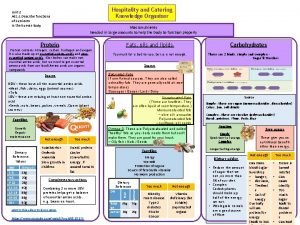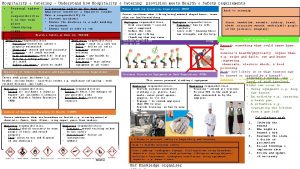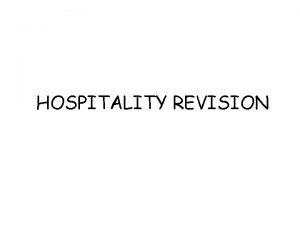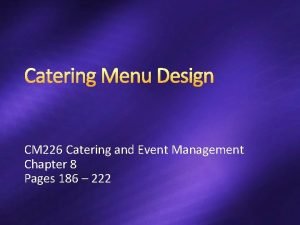LO 2 Hospitality Catering Understand how Hospitality catering





- Slides: 5

LO 2: Hospitality & Catering – Understand how Hospitality & catering provisions operate AC 2. 1 - Describe the operation of the kitchen • • • Layout Work flow Operational activities Equipment & materials Stock control Documentation & administration • Staff allocations] • Dress code Correct Kitchen layout Allows; • • staff to work safely high levels of food hygiene • enough space for everyone to work efficiently and quickly to manage orders • Efficient work flow • Create sections to avoid cross-contamination Key terms Work Flow -the way food passes through the kitchen from the delivery to dining room. FIFO- first in first out using food stocks in rotation. Covers- customer food order that are sent to the Kitchen Work flow. Should be in one direction using different areas so that the clean stages in food production never come into contact with the ‘dirty’ stage. Delivery and storage Food preparation Cooking serving Holding Cleaning Operational activities in the kitchen follow the efficient workflow: 1. Goods are received and stored 2. Food is prepared for cooking. 3. The food is cooked. Delivery Ensure vehicles have access to the premises Storage Store close to the delivery area so delivery drivers do not need to enter the food prep areas. Cooking • Consider requirements of menu and ability of staff. • Flow must suit style of service e. g. fryers and grill near to point of service for fast cooking and bulk cooking further away. • Need work surface beside cooking equipment so there is somewhere to put foods down. • Gas and electric supply near to cooking equipment Waste Try to keep separate from food preparation area Storage that is pest proof 4. the food is dished up and served. 5. Service 6. cleaning and maintaining the kitchen Food preparation should be between storage and cooking areas. • Separate different processes e. g. raw meat away from prepared foods. • Separate high risk food areas. • Need sinks, pot wash facilities and hand washing. • If separation by areas are not possible, then do all preparation before cleaning down for cooking. Holding • Needs to be near the food service area • Hot holding needs to be over 63°C • Cold holding in chillers 0°C -5°C Food service • Should be located close to the cooking process so handling is minimized • Area for plating up A la Carte restaurant • Replenish food during service for buffet and counters Cleaning Washing up – space for sinks & dishwashers. Areas for dirty items before washing and for clean items after washing needs to be separated to prevent cross-contamination H&C Knowledge organiser: term 2

LO 2: Hospitality & Catering – Understand how Hospitality & catering provisions operate Kitchen Hygiene Kitchens should be well lit and well ventilated with fresh air. Easy to clean – stainless steal work surfaces, smooth wipe able walls, hardwearing and non-slip flooring. Equipment & materials A lot of kitchen equipment is stainless steal because it is strong, easy to clean and does not rust. Good quality kitchen equipment is expensive but s essential for efficient & safe food production. Large equipment Documentation and administration Stock control • stock control ensures that ingredients are in good condition and are safe to eat. • First in first out (FIFO) ensures older stock is used first. • All food deliveries should be checked and moved to the most appropriate area within 15 minutes Perishables foods which do not stay fresh for very long e. g. milk, and milk products, meats, fish Staple foods Floor standing mixers Ovens Double fridges Salamander grill • • • Have a longer shelf life Often bought in bulk as cheaper E. g. flour, sugar, salt, fat, oil, dried lentils and beans, condiments etc. Materials Blast chillers Food steamer Small equipment Deep fat fryer • Bowls • Jugs Knives • mincers 1. Store knives safely e. g. • Hand held mixers in a knife block • spatulas 2. Use knives for the • chopping boards purpose they were • Sieves intended. • Colanders 3. Cut with a slicing • Liquidiser/blender action food probes etc. 4. Clean after use do not • leave in a filled sink. colour coded equipment to prevent cross contamination Besides equipment and ingredients catering kitchens need the following to operate effectively; Bin cards – labels on stock to show much has been used and so it can be reordered when low. Stock ledger – a detailed list of all stock, usually kept on a computer system. Requisition stock book- allows ingredients/foods to be ordered from the stock room. Oder books- ordering stock. Delivery notes – used to check when orders delivered, price and amounts. Invoices – food good ordered. Food and safety documentation- temperature checks of the fridge & freezers. Food hygiene and safety regulations Health and safety documentation –health and safety certificates for all staff Accident book to record any accidents at work • detergents- remove dirt& grease • Disinfectants – to destroy bacteria Importance of documentation • Sanitiser- for cleaning & disinfecting • Oven gloves Hospitality & Catering establishments have a legal responsibility to work safely and hygienically. Records are kept to evidence proof of due diligence. • Tea towels Staff allocations- Kitchen • First aid kit Staff are allocated roles & responsibilities according to their qualifications & experience. • Dustpans& brushes, mops • Aprons, disposable kitchen cloths, hand wash and paper towels Key words Kitchen brigade – the organisational hierarchy of staff in a professional kitchen. Dress code – a set of rules outlining the clothing to be worn by people. Stock - All materials, ingredients and equipment are called stock. H&C Knowledge organiser: term 2 Keeping documents is important for the success of a business as it helps to maintain good organisation, the safety of the workers & customers and ensures that bills are paid on time. Head chef AC 1. 2 job roles Sous chef Pastry chef Larder chef Sauce chef Vegetable chef Commis chef Kitchen assistant Kitchen porter

LO 2: Hospitality & Catering – Understand how Hospitality & catering provisions operate Kitchen dress code A chef’s uniform plays an important part in protecting form potential dangers common in most kitchens Long hair tied back Hat/hairnet Chef’s jacket Blue plasters to cover cuts Clean teeth & clean shaven Clean hands nails Apron from waist to knee Baggy trousers AC 2. 2 Describe the operation of front of house • Layout • Work flow • operational activities • Equipment & materials • Staff allocations • Dress code • Safety & security Activities What happens? Reception Customer check in & out, book tables & find out information. Lounge Asocial area where guests can relax or wait for their table. Bar Where drinks can be ordered Restaurant Where guests can sit and eat a meal Toilets & cloakroom Where guests can leave coats & use the facilities Safety & security Measures are put in place to prevent illness and accidents ensuring that workers are safe. Factors affecting health, safety& security • • • • Mixing & cutting equipment Inhalation of flour dust Open gas jets or flames Sharp knives Monitoring well being in a busy working environment Staff need a secure place for personal belongings Locking doors & windows Honest staff Secure outside lighting Staff training Safes for money CCTV Hotels/restaurants need to be clearly logically set out so people can move from one area to another easily • Reception • Bar • Lounge • Dining area • Toilets & cloakroom Operational activities –front of house Steel toe capped shoes Chef’s uniform • Chef jacket • Chef’s pants • Hat • Neckerchief • Apron • Hand towel • Slip resistant shoes Front of house Layout • • • Work flow Meet & greet Show to table and issue a menu Take drinks orders, serve drinks, take food order & send to kitchen Serve meal to custome rs & check on them Clear the table when finished, offered desserts/ coffee, send order to kitchen Clear table, issue bill, take payment, customer leaves Reset the table for the next customer Front of house equipment Table top- napkin, table cloths, menu holders, condiment sets, jugs, butter dishes, candle holders, vase, sugar bowls, bread baskets etc. Food service- china & ceramic plates, dishes , bowls, sizzle platters, ramekin dishes etc. Waiting table- trays, stands, serving spoons, tongues, computer generated customer ordering and payment equipment, pens. notepads etc. Customer seating- chairs, stools, high chairs, booster seats, armchairs etc. Organisation- rope barriers for queuing, direction signs, menu posters, chalk boards, wine racks etc. First Aid & safety – first aid kit, emergency exit signs, fire extinguishers Smoke and gas alarms, safety lighting Breakable/ unbreakable Safety features How heavy? E. g. plates and serving dishes How easy is it to clean? considerations Easy to stack/store? Dishwasher safe? Stock control Stock for the front of house is monitored the same way as stock in the kitchen. There will be someone different in charge of monitoring it. Similarly there will be different people monitoring stock like cleaning materials and beverages. • All electrical equipment must be checked for safety every year. • All equipment on view in food service area should be spotlessly cleaned and polished daily. • The temperatures of hot & cold food service areas should be monitored daily. • Coffee machines should be kept clean and serviced regularly. Materials besides equipment and ingredients the front of house needs a continuous supply of: Cleaning materials e. g. detergent, washing up cloths, mops, brooms, buckets to clean tables/bar area Find out how EPOS works /floor/toilets/waiting areas Materials for food service e. g. napkins, individual sachet of condiments, milk, sugar, flowers, candles etc. Waste disposal materials- recycling waste bags/bins ( recycling) Employee welfare –first aid/hand wash/paper towels/etc. Maintenance – filters for extractors/light bulbs/replacement broken equipment. H&C Knowledge organiser: term 2

LO 2: Hospitality & Catering – Understand how Hospitality & catering provisions operate AC 2. 2 Documentation & administration Document Description • Stock ledger- detailed list of all stock, kept on the computer • Requisition book –each department has in order to draw stock from the store for the front of house • order book- order stock • Delivery notes –used to check deliveries are correct • Invoices- for good/services ordered • Services used – e. g. laundry of sheet & towels • Financial & budget information- over seeing spending in all departments • Health & safety documentation health & safety certificates for all staff, accident book to record accidents at work • Employees- documents on all employees e. g. training records, sickness, accidents at work, hours worked, wages, national insurance • Customer documentation- for checking customers in & out, feedback, and management of events. AC 2. 3 How hospitality & catering provisions meet customer needs • Leisure • Business/corporate • Local residents Requirements • Customer needs, expectations • Customer trends • Customer rights, equality Local customer requirements Value for money Good service/standard so they return Catering for local needs ( culture, religion) Loyalty schemes Recognised by staff- feel welcome Menu specials Child friendly Entertainment Mailing list for special offers Dress code Front of house staff have to look smart, often have a corporate uniform. Room attendants –uniform covered by an apron for cleaning. Waiting staff – have a uniform that is designed to be smart, be hygienic and safe. Leisure requirements Value for money Good facilities Child menus/play areas for families with children Tourists want local food Older people want a more formal service Varied choice of menu Dietary needs catered for Facilities for physical/visual impaired customers Trip hazards Monitoring well-being in a busy working environment Vandalism by customers Factors affecting health, safety & security Theft of cutlery & glasses Business/corporate customer requirements • Discounted rates • Meeting rooms • Water/juice on tables • Presentation equipment, projector etc. • Office facilities, printer , phone internet etc. • Tea/coffee for breaks • Lunch or other meals • Accommodation for attendees if travelled a long distance • Quick service for lunch meetings Secure place to leave belongings Dealing with aggressive /drunk customers Staff allocations see term 1 KO for individual roles Staff are allocated roles & responsibilities in front of house according to their qualifications & experiences Customer trends Influenced by: • • • TV Magazines Health Travel Technology Ratings & reviews H&C Knowledge organiser: term 2


